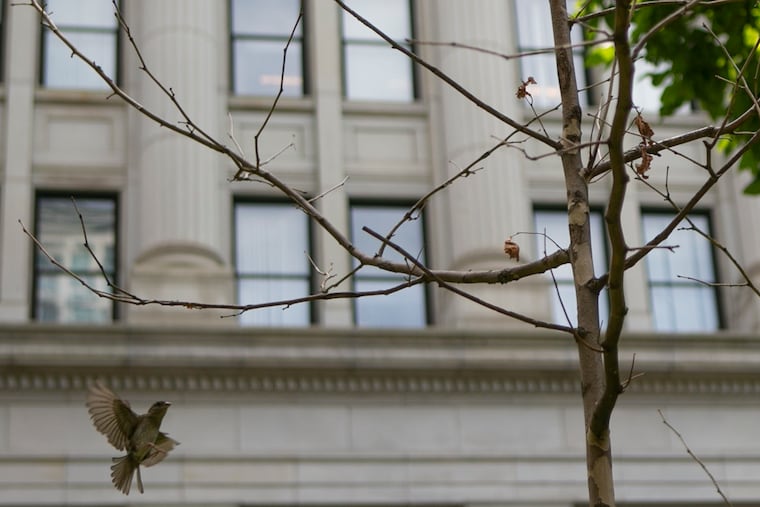What’s happening to Philly’s moon trees? One died, and now its clone is dying, too.
The troubled tale of a tree taken to the moon.

Born of a sycamore seed that was taken on a voyage to the moon, Philadelphia’s “moon tree” stood for nearly four decades in Washington Square — a testament to humanity’s curiosity and its inextricable connection to Earth.
But like many living things, the tree — which came from a seed taken aboard Apollo 14 on its 1971 lunar journey — grew sick and died.
In 2011, Independence National Historical Park cut down the moon tree, one of about 60 around the world, and replaced it with a clone made by Morris Arboretum.
Now, that clone is dying, too.
Skinny and scraggly, the cloned moon tree stands alone and bare surrounded by lush greenery inside the entrance to Washington Square at Sixth and Walnut Streets. It holds tight to its five brown, thirsty leaves that will likely be four by the time you read this.
Only the plaque reading “Bicentennial Moon Tree” indicates that it’s anything special, and even the plaque, which was for the original tree, is now outdated.
A reader who believed the tree was the original asked The Inquirer’s “Curious Philly” question-and-answer platform: “It’s obviously dead. Why is it still there? Does it mean that life ceases to exist if it goes to the moon?”
Philly’s original moon tree was planted in 1975 with a seed astronaut Stuart Roosa took to the moon and back aboard Apollo 14, a mission that took place two years after humans set foot on the moon 50 years ago this week.
Anthony Aiello, curator and director of horticulture at Morris Arboretum, said the cause of death of Philly’s original moon tree is unknown, and he’s not sure what’s happening to the clone either.
“I don’t think it has anything to do with going to the moon, though, because there are a fairly good number of them still around,” he said.
In fact, when Morris Arboretum cloned the first moon tree, it made another clone, which was planted at the Montgomery County Courthouse in 2015.
Barry Jeffries, Montgomery County Planning Commission design planner, said the tree didn’t grow too much in the first year, but it’s doing well now.
“Ours is healthy. It’s very healthy,” he said. “It’s put out a lot of canopy and coverage this year.”
Adam Duncan, spokesman for Independence National Historical Park, which oversees Washington Square, said there are no plans to remove the cloned moon tree — yet.
“However, we are monitoring the tree,” he wrote in an email. “Our preference would be to replace it with another clone.”
If that happens, Aiello said, the best bet for a successful clone would be to make one from the flourishing moon tree in Montgomery County.
Roosa, a former U.S. Forest Service employee, took 400 tree seeds — ranging from sycamore to sweet gum — with him aboard Apollo 14. As his comrades descended to the lunar surface, Roosa and the seeds orbited the moon 34 times.
Upon Apollo 14′s return, the Forest Service planted the seeds and then handed out the trees as gifts during the nation’s Bicentennial celebration. Other recipients of moon trees include the White House, the Kennedy Space Center, and the University of Florida.
Inexplicably, Philadelphia’s “Bicentennial Moon Tree” was actually planted in 1975. Roosa attended the dedication. His son attended the dedication of the cloned moon tree in 2011.
The plaque that has sat before both trees reads, in part: “Honoring Earth’s green world of trees.”
On Wednesday, 23-year-old Alfonso Robles, who was visiting Philadelphia from Mexico with his family, stopped to read the plaque and took a photo of the tree.
For while the tree may not be beautiful, he thinks its story still is.
“It’s really cool that they took a seed to the moon and decided to put it in the Earth here in Philadelphia," Robles said.
» MORE CURIOUS PHILLY: Why Philly’s official temperature is taken at the airport
» MORE CURIOUS PHILLY: Why this 85-year-old woman has been silently picketing along Route 1 for 11 years and counting